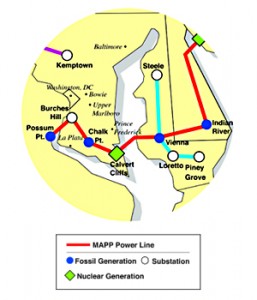PEPCO is falling down on the job
December 12th, 2010
Nearly two years ago, I attended a hearing for the Delmarva Power Integrated Resource Plan, which was the most bizarre hearing I’ve ever experienced. At that time, I raised issues about decreasing demand, entered into the record the PJM demand documents that we’d used in the Susquehanna-Roseland transmission docket in New Jersey (also PJM), and raised concerns that no SAIDI, SAIFI and CAIDI reliability info was reported. After that meeting, I presented Delmarva Power’s attorney Todd Goodman with a well-deserved “Horse’s Ass” award for his performance at that meeting. The points I’d raised at that meeting about what was missing in their “IRP” were oh-so-valid:
It took a while, but last week, the Washington Post featured an article showing that PEPCO, utility in D.C. and Maryland, and the corporate parent of Delmarva Power, has an inexcusably miserable record for outages. That’s something that’s demonstrated in the SAIDI, SAIFI and CAIDI reports! And folks, don’t go conflating transmission with distribution as the cause for the outages, as utilities would have you do. Anyway, here’s that article:
Washington Post Analysis: Why PEPCO can’t keep the lights on
As you read the article, note there’s not a word on D-E-R-E-G-U-L-A-T-I-O-N as a contributory factor, much less the primary reason.
Washington Post analysis: Why Pepco can’t keep the lights on
Moreover, Pepco has long blamed trees as a primary culprit for the frequency and duration of its outages, implying that the problem is beyond its control. But that explanation does not hold up under scrutiny, The Post analysis found. By far, Pepco equipment failures, not trees, caused the most sustained power interruptions last year.
Read the rest of this entry »
National Wind/AWA Goodhue PPAs ARE public record!
June 23rd, 2010
As seen on Hwy. 52 between the Zumbrota exits
Goodhue County is considering modifications of their wind ordinance, and have formed a committee to look at it with county planning staff.
And here is the draft ordinance, in pdf’d Track Changes:
Here is the report from the Rochester Post Bulletin:
First draft of Goodhue County’s new wind regulations proves unpopular
And from June 15th Beagle:
We were there to address specifics about proposed changes, and the discussion was wide ranging.
Ben Kerl, National Wind/AWA Goodhue (or whatever their name may be today!) made some astounding statements yesterday. He actually said, regarding Goodhue County’s ordinance proposal for wind projects, where they proposed to require a copy of the Power Purchase Agreement, to demonstrate it’s not a vaporware project, to help assure “they wouldn’t build an empty building,” and he had the audacity to say that he objected to this requirement, and that he’d have to check with Xcel to see if it could be disclosed. IF IT COULD BE DISCLOSED!!!
EXCUUUUUUUUSE MEEE?!?! It’s already public information (redacted a tad-bit), it’s already a public document:
The PPA provided in the PPA dockets would be sufficient to satisfy the county’s concerns.
That statement of Kerl’s was SO egregious I just couldn’t sit there and let it slide.
These PPAs above are from the Goodhue PPA dockets at the PUC. To review the full PPA dockets:
- Go to www.puc.state.mn.us; and
- Click on “search documents;” and
- Search for dockets 09-1348 and 09-1350 (they’re pretty much identical).
Oh, and we were discussing a Property Protection Plan as has been established in other jurisdictions, where the developer essentially guarantees that the property values will not be lower. Steve Groth raised that issue, and of course Ben Kerl objected, and thought it essentially a black hole of liability that would quash funding. I raised the “Buy the Farm” provision for transmission as something that is used in transmission to assure that if a landowner wants out, that they could do so.
CLICK HERE for Minn. Stat. 216E.12 — “Buy the Farm” and go down to Subd. 4.
There’s more, but that requires a little background work, so stay tuned. In the meantime…
Shame on you, Ben Kerl…
Baltimore: Rally on Tuesday — say NO to transmission for coal!
November 29th, 2009
It’s so good to be home … for a second or so, that is, before the CapX 2020 Brookings public and evidentiary hearings start. For more on that, go to NoCapX 2020!
PJM’s Mid-Atlantic Power Pathway is in the news again… or is it PEPCO… or is it Delmarva Power… yes, another stupid transmission idea comin’ down the pike… it’s time to say NO! to transmission for coal!
Join the “No New Coal” brigade at the rally:
Baltimore’s Preston Gardens Park
Don’t get confused by this map of MAPP — they’re now admitting that the part from Indian River to Salem “isn’t needed” and it’s only a matter of time before they figure out that a 500kV line to nowhere isn’t needed either.

From The Diamondback, the University of Maryland’s paper – YES! maybe there’s hope, maybe they’ll do a better job than we have:
MAPP and PATH: Time to draw the line
Are people starting to get it? Here’s another from the Diamondback:
Guest column: Toppling King Coal
Krishna Amin is a junior biochemistry major. She can be reached at krish121 at umd dot edu.




